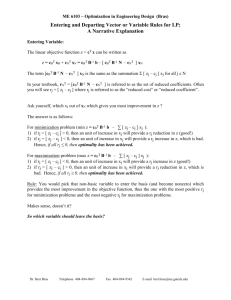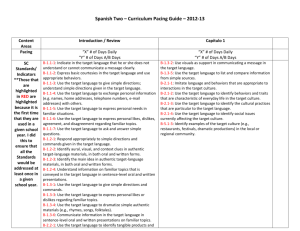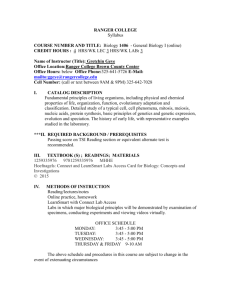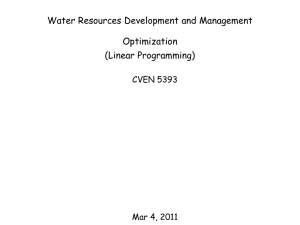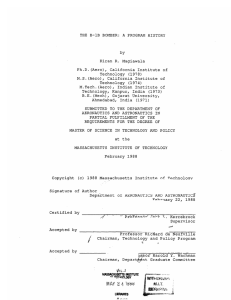B-1B Lancer - Blogs @ Butler
advertisement
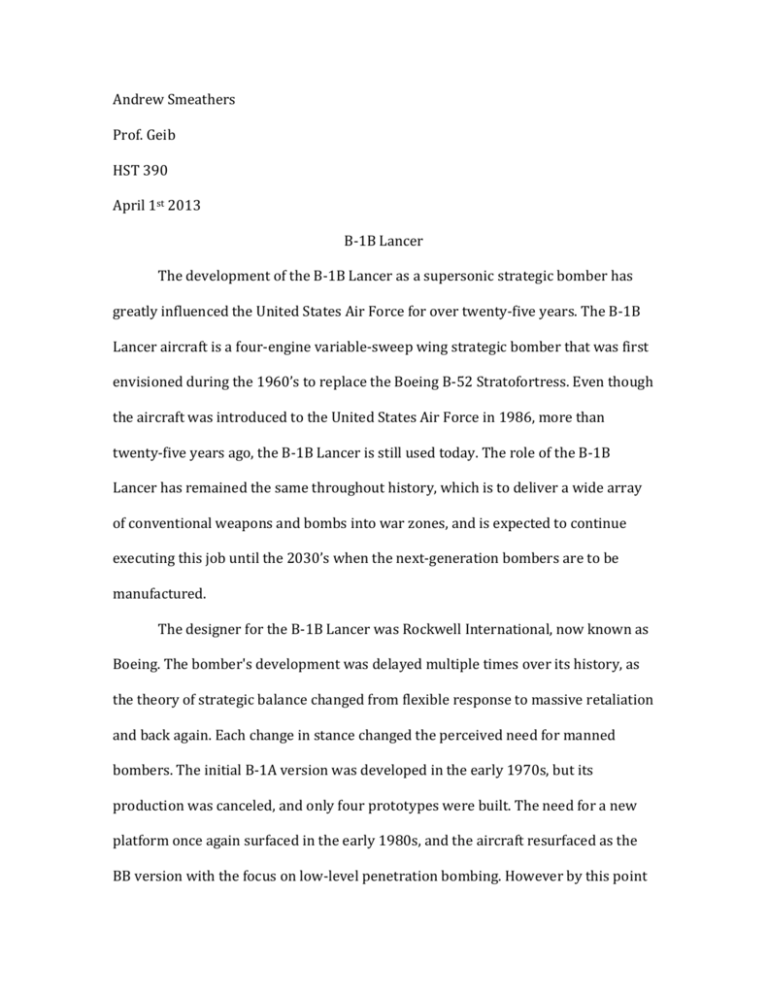
Andrew Smeathers Prof. Geib HST 390 April 1st 2013 B-1B Lancer The development of the B-1B Lancer as a supersonic strategic bomber has greatly influenced the United States Air Force for over twenty-five years. The B-1B Lancer aircraft is a four-engine variable-sweep wing strategic bomber that was first envisioned during the 1960’s to replace the Boeing B-52 Stratofortress. Even though the aircraft was introduced to the United States Air Force in 1986, more than twenty-five years ago, the B-1B Lancer is still used today. The role of the B-1B Lancer has remained the same throughout history, which is to deliver a wide array of conventional weapons and bombs into war zones, and is expected to continue executing this job until the 2030’s when the next-generation bombers are to be manufactured. The designer for the B-1B Lancer was Rockwell International, now known as Boeing. The bomber's development was delayed multiple times over its history, as the theory of strategic balance changed from flexible response to massive retaliation and back again. Each change in stance changed the perceived need for manned bombers. The initial B-1A version was developed in the early 1970s, but its production was canceled, and only four prototypes were built. The need for a new platform once again surfaced in the early 1980s, and the aircraft resurfaced as the BB version with the focus on low-level penetration bombing. However by this point development of stealth technology was promising an aircraft of dramatically improved capability. Production went ahead as the B version would be operational before the "Advanced Technology Bomber" (which became the B-2 Spirit), during a period when the B-52 would be increasingly vulnerable. The B-1B entered service in 1986 with the USAF Strategic Air Command as a nuclear bomber. The B-1 program was initially during President Richard Nixon’s term, and was later shut down during Jimmy Carter’s term. During Ronald Regan’s presidency the B-1B program was resurrected and has been around ever since. The main question that Regan had to answer was if the B-1B would have a larger impact in the short term rather than waiting for the development of the ATB’s (advanced technology bomber). Several Air Force studies suggested that the existing B-52 fleet with ALCM (air-launched cruise missile) would remain a credible threat until 1985, as it was predicted that 75% of the B-52 force would survive to attack its targets. After this, the introduction of the SA-10 missile, the MiG-31 interceptor and the first Soviet airborne early warning and control (AWACS) systems would make the B-52 increasingly vulnerable. During 1981, funds were allocated to a new study for a bomber for the 1990s time frame; this led to the Long-Range Combat Aircraft (LRCA) project. The LCRA evaluated the B-1, F-111, and ATB as possible solutions; an emphasis was placed on multi-role capabilities, as opposed to purely strategic operations. In 1981, it was believed the B-1 could be in operation before the ATB, covering the transition period between the B-52's increasing vulnerability and the ATB's introduction. Reagan decided the best solution was to procure both the B-1B and ATB, and on 2 October 1981 Reagan announced that 100 B-1s were to be ordered to fill the LRCA role (Vanden Brooke 7). In January 1982 the U.S. Air Force awarded two contracts to Rockwell worth a combined $2.2 billion for the development and production of 100 new B-1 bombers. Numerous changes were made to the design to make it better suited to the now expected missions, resulting in the new B-1B. These changes included a reduction in maximum speed, which allowed the variable-aspect intake ramps to be replaced by simpler fixed geometry intake ramps in the newer design. This reduced the B version's radar signature; the reduction in radar cross-section was seen as a good trade off for the speed decrease. High subsonic speeds at low altitude became a focus area for the revised design, and low-level speeds were increased from about Mach 0.85 to 0.92. The B-1B has a maximum speed of Mach 1.25 at higher altitudes. The B-1B's maximum takeoff weight was increased to 477,000 pounds. The weight increase was to allow for takeoff with a full internal fuel load and for external weapons to be carried. Rockwell engineers were able to reinforce critical areas and lighten non-critical areas of the airframe, so the increase in empty weight was minimal. In order to deal with the introduction of the MiG-31 and other aircraft with look down capability, the B-1B's electronic warfare suite was significantly upgraded (Baugher 24). Opposition to the plan was widespread within Congress. Critics pointed out that many of the original problems remained in both areas of performance and expense. In particular it seemed the B-52 fitted with electronics similar to the B-1B would be equally able to avoid interception, as the speed advantage of the B-1 was now minimal. It also appeared that the "interim" time frame served by the B-1B would be less than a decade, being rendered obsolete shortly after the introduction of a much more capable ATB design. The primary argument in favor of the B-1 was its large conventional payload, and that its takeoff performance allowed it to operate with a credible bomb load from a much wider variety of airfields. The Air Force spread production subcontracts across many congressional districts, making the aircraft more popular on Capitol Hill. The first B-1B was completed and began flight-testing in March 1983. The first production B-1B was rolled out on 4 September 1984 and first flew on 18 October 1984. The 100th and final B-1B was delivered on 2 May 1988; as a point of controversy, even before the last B-1B was delivered, the Air Force had determined that the aircraft was vulnerable to Soviet air defenses. The B-1 has a blended wing body configuration, with variable-sweep wing, four turbofan engines, and triangular fin control surfaces. The wings can sweep from 15 degrees to 67.5 degrees. Forward-swept wing settings are used for takeoff, landings and high-altitude maximum cruise. Aft-swept wing settings are used in high subsonic and supersonic flight. The B-1's variable-sweep wings and thrust-toweight-ratio provide it with better takeoff performance, allowing it to use more runways than previous bombers. The length of the aircraft presented a flexing problem due to air turbulence at low altitude. To alleviate this, Rockwell included small triangular fin control surfaces or vanes near the nose on the B-1. The B-1's Structural Mode Control System rotates the vanes automatically to counteract turbulence and smooth out the ride (Boeing 6). "The Star of Abilene", was the first B-1B delivered to the USAF Strategic Air Command (SAC) in June 1985. Initial operational capability was reached on 1 October 1986 and the B-1B was placed on nuclear alert status. The B-1 received the official name "Lancer" on 15 March 1990. However, the bomber has been commonly called the "Bone"; a nickname that appears to stem from an early newspaper article on the aircraft wherein its name was phonetically spelled out as "B-ONE" with the hyphen inadvertently omitted. In late 1990 engine fires in two Lancers caused the grounding of the fleet. The cause was traced back to problems in the first-stage fan, the aircraft were placed on "limited alert"; in other words, they were grounded unless a nuclear war broke out. Following inspections and repairs they were returned to duty beginning on 6 February 1991. Due to the engine problems, the B1B was effectively sidelined in the First Gulf War (Baugher 13). Originally designed strictly for nuclear war, the B-1's development as an effective conventional bomber was delayed until the 1990s. The collapse of the Soviet Union had brought the B-1's nuclear role into question, leading to President George H. W. Bush ordering a $3 billion conventional refit. By 1991, the B-1 had a fledgling conventional capability, forty of them able to drop the 500 lb. (230 kg) Mk82 General Purpose (GP) bomb, although mostly from low altitude. Despite being cleared for this role, the problems with the engines precluded their use in Operation Desert Storm. B-1s were primarily reserved for strategic nuclear strike missions at this time, providing the role of airborne nuclear deterrent against the Soviet Union. (Baugher 15). The B-52 was more suited to the role of conventional warfare and coalition forces used it instead. After the de-activation of Strategic Air Command (SAC) and the establishment of the Air Combat Command (ACC) in 1992, the B-1 developed a greater conventional weapons capability. Part of this development was the start-up of the U.S. Air Force Weapons School B-1 Division. In 1994, two additional B-1 bomb wings were also created in the Air National Guard, with former fighter wings in the Kansas Air National Guard and the Georgia Air National Guard converting to the aircraft. By the mid-1990s, the B-1 could employ GP weapons as well as various CBU’s (Cluster Bomb Units). By the end of the 1990s, another upgrade, the B-1 boasted a full array of guided and unguided munitions. The B-1B no longer carries nuclear weapons; its nuclear capability was disabled by 1995 with the removal of nuclear arming and fuzzing hardware (Boeing 3). Operationally, the B-1 was first used in combat in support of operations against Iraq, during Operation Desert Fox in December 1998, employing unguided GP weapons. B-1s have been subsequently used in Operation Allied Force (Kosovo) and, most notably, in Operation Enduring Freedom in Afghanistan and the 2003 invasion of Iraq. The B-1 has deployed an array of conventional weapons in war zones, most notably the GBU-31, a 2,000 lb (900 kg) Joint Direct Attack Munitions (JDAM). JDAM munitions were heavily used by the B-1 over Iraq, notably on April 7th, 2003, in an unsuccessful attempt to kill Saddam Hussein and his two sons (Vanden Brooke). At the height of the Iraq War, a B-1 was permanently airborne to provide rapid precision bombardment upon important targets as intelligence identified them. During Operation Enduring Freedom, the B-1 was able to raise its mission capable rate to 79% (Air Attack 9). The B-1 has higher survivability and speed when compared to the older B-52, which it was intended to replace. It also holds 61 FAI (Federation Aeronautical International) world records for speed, payload, distance, and time-to-climb in different aircraft weight classes. In November 1983, three B-1Bs set a long distance record for the aircraft, which demonstrated its ability to conduct extended mission lengths to strike anywhere in the world and return back to base without any stops. The National Aeronautic Association recognized the B-1B for completing one of the 10 most memorable record flights for 1994 (Baugher 8). Of the 100 B-1Bs built, 93 remained in 2000 after losses in accidents. In June 2001, the Pentagon sought to place a third of its then fleet of 93 into storage; this proposal resulted in several U.S. Air National Guard officers and members of Congress lobbying against the proposal, including the drafting of an amendment to prevent such cuts. The 2001 proposal was intended to allow money to be diverted to further upgrades to the remaining B-1Bs, such as computer modernization. In 2003, accompanied by the removal of B-1Bs from the two bomb wings in the Air National Guard, the USAF decided to retire 33 aircraft to concentrate its budget on maintaining availability of remaining B-1Bs (B-1B 7). In 2004 a new appropriation bill called for some of the retired aircraft to return to service, and the USAF returned seven mothballed bombers to service to increase the fleet to 67 aircraft. (Thompson 4) On 14 July 2007, the Associated Press reported on the growing USAF presence in Iraq as a result of "surge" in forces. Also mentioned is the reintroduction of B-1Bs to be a close-at-hand "platform" to support Coalition ground forces. B-1s have been used in Iraq and Afghanistan. Since 2008 B-1s have been used there in an "armed over watch" role. They loiter over the region maintaining surveillance, ready to deliver guided bombs in support of ground troops if contacted. The USAF had 65 B-1Bs in service in September 2010, split between four squadrons organized into two Bomb Wings: the 7th Bomb Wing at Dyess AFB, Texas, and the 28th Bomb Wing at Ellsworth AFB, South Dakota. In March 2011, B-1Bs from Ellsworth Air Force Base attacked undisclosed targets in Libya as part of Operation Odyssey Dawn (Baugher 12). With upgrades to keep the B-1 viable, the Air Force may keep the bomber in service until approximately 2038. Despite upgrades, the B-1 has repair and cost issues resulting from its age. For every flight hour it needs 48.4 hours of repair. The fuel, repairs and other needs for a 12-hour mission cost $720,000 as of 2010. The $63,000 cost per flight hour is, however, less than the $72,000 for the B-52 and the $135,000 of the B-2. In June 2010, senior US Air Force officials met to consider retiring the entire fleet to meet budget cuts (Baugher 14). It is expected to be supplemented by the next generation bombers in the 2020s. In the meantime, its "capabilities are particularly well-suited to the vast distances and unique challenges of the Pacific region, and we'll continue to invest in, and rely on, the B-1 in support of the focus on the Pacific" as part of President Obama's “Pivot to East Asia” (Vanden Brooke 3). Bibliography Air Attack. " B-1B Lancer." Air Attack. N.p., 2010. Web. 03 Apr. 2013. "B-1B Lancer Long-Range Strategic Bomber, United States of America." Air Force Technology. Net Resources, 2012. Web. 03 Apr. 2013. Baugher, Joseph F. "Rockwell B-1B Lancer." Airfighters.com. N.p., 8 May 2007. Web. 1 Apr. 2013. Boeing. "History." B-1 Lancer Bomber. N.p., n.d. Web. 1 Apr. 2013. Thompson, Mark. "Bombers Away? The B-1 Could Be Near Its Demise." Time Magazine. Time, 3 June 2010. Web. 1 Apr. 2013. Vanden Brooke, Tom. "USA TODAY." USATODAY.COM. N.p., 8 July 2012. Web. 03 Apr. 2013.
